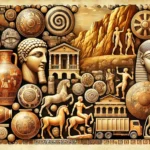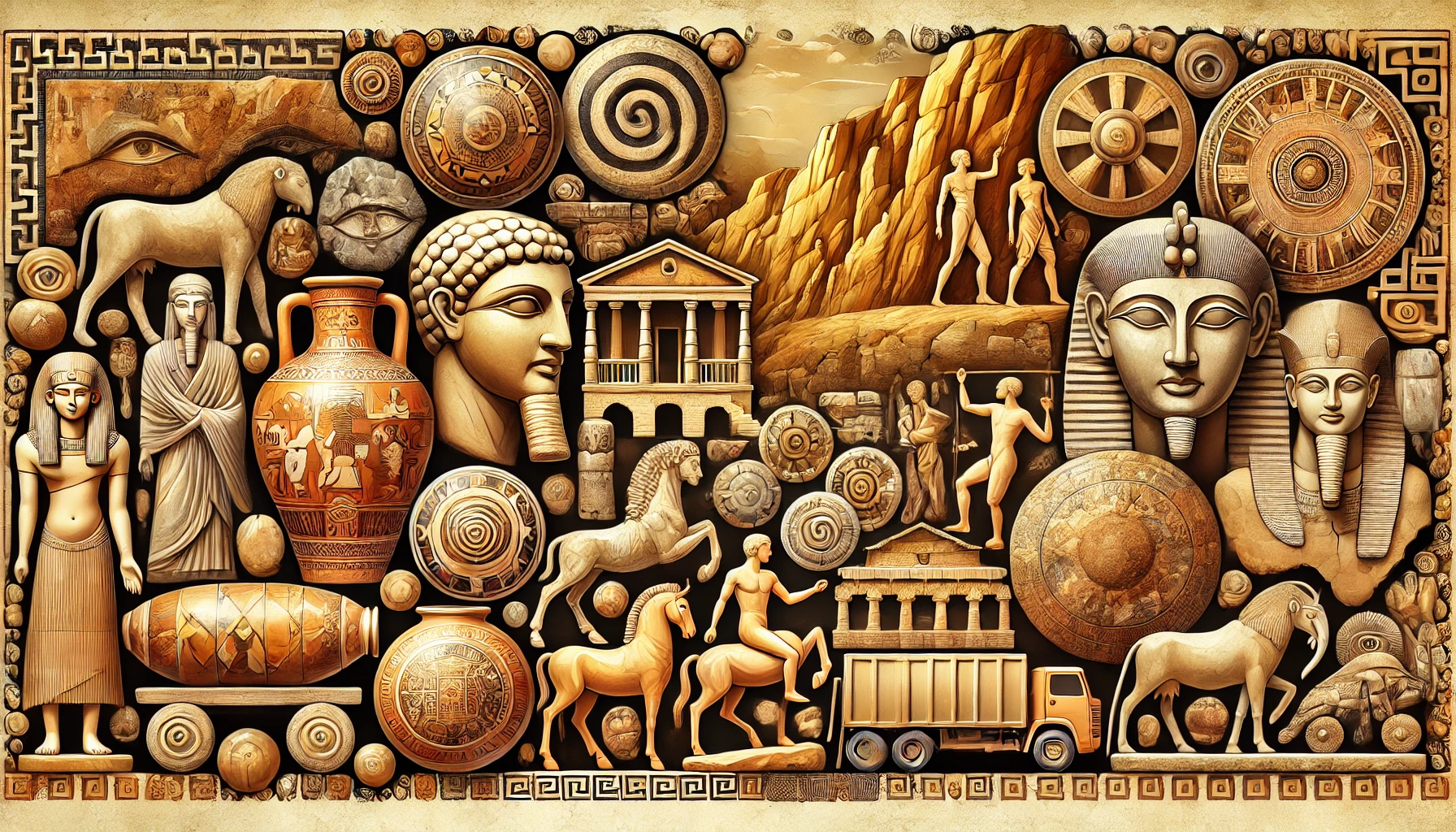Throughout human history, art has served as a window into the past, offering us glimpses of the lives, beliefs, and cultures of ancient civilizations. Ancient artz, or ancient art forms, span the globe, representing diverse cultures and periods. From the earliest cave paintings to intricate sculptures, these artistic creations reflect the ingenuity, creativity, and cultural significance of those who came before us.
This article delves deep into ancient art, examining its origins, the techniques used by early artists, the purposes it served, and its impact on modern art and society. We will explore different regions of the world, such as Mesopotamia, Egypt, Greece, Rome, China, and the Americas, showcasing how art evolved in these regions and the cultural importance of each period’s artistic endeavors. Additionally, we will examine how the legacy of ancient art continues to influence modern creativity.
What is Ancient Art?
Ancient art refers to artistic expressions created by civilizations before the fall of the Roman Empire in 476 CE. These works of art include a wide range of media, such as paintings, sculptures, pottery, jewelry, architecture, and decorative objects. The defining characteristic of ancient art is that it was often created for religious, ceremonial, or practical purposes. Ancient artz was closely intertwined with the daily life, beliefs, and customs of the people who produced it.
Some of the earliest known examples of art can be traced back to prehistoric times, with cave paintings like those found in Lascaux, France, dating back over 17,000 years. As societies developed and became more complex, so did their artistic expressions, evolving to include more detailed and sophisticated forms of art that served various functions—from worship to political propaganda.
The Role of Ancient Art in Society
Art in ancient times was not simply created for aesthetic enjoyment; it served numerous purposes in society. Here are a few of the key roles that ancient artz played in various civilizations:
1. Religious and Spiritual Expression
Many ancient artz forms were closely tied to religious and spiritual practices. Temples, sculptures of deities, and ritual objects were created to honor gods, ancestors, and the forces of nature. In Egypt, for example, elaborate tomb paintings and statues of pharaohs were believed to help the deceased in the afterlife.
2. Political Propaganda
Art was often used as a tool for political power. Rulers would commission grand statues, murals, and monuments to demonstrate their authority, strength, and divine right to rule. The Roman Empire is well-known for its use of statues and reliefs to celebrate military victories and showcase the power of emperors.
3. Cultural Preservation
Ancient artz served as a means of preserving cultural identity and history. Pottery, carvings, and inscriptions often depicted daily life, important events, and social customs, helping future generations understand their ancestors’ way of life. In many cases, these artistic records are the only remaining evidence of ancient cultures.
4. Aesthetic Enjoyment
Although functionality was often a primary concern in ancient artz, many cultures also valued beauty and craftsmanship. Intricate designs in pottery, jewelry, and textiles demonstrate an appreciation for aesthetic appeal, even in everyday objects.
5. Funerary and Burial Practices
Funeral art, such as tombs, grave markers, and sarcophagi, was prominent in many ancient civilizations. These artworks were created to honor the dead and ensure a peaceful afterlife. Ancient Egypt, in particular, is known for its elaborate tombs, like the pyramids, which were filled with artistic treasures to accompany the deceased into the afterlife.
The Evolution of Ancient Art Across Civilizations
To understand the breadth and diversity of ancient artz, it’s essential to explore the different regions where ancient art flourished. Below, we will examine the unique characteristics and contributions of ancient artz from Mesopotamia, Egypt, Greece, Rome, China, and the Americas.
1. Mesopotamian Art
Mesopotamia, often referred to as the “cradle of civilization,” was home to some of the earliest known art forms. This region, located between the Tigris and Euphrates rivers (modern-day Iraq and parts of Syria), was home to the Sumerians, Akkadians, Babylonians, and Assyrians.
- Cuneiform Writing: One of Mesopotamia’s most significant contributions to art was the invention of cuneiform writing, which was often inscribed on clay tablets. These tablets served as records of transactions, religious texts, and even literary works.
- Ziggurats: Mesopotamian architecture included massive terraced structures called ziggurats, which were built as temples to honor the gods. These impressive structures were adorned with carvings and statues.
- Sculpture and Reliefs: Mesopotamian rulers commissioned large statues and reliefs that depicted military victories, religious ceremonies, and everyday life. These artworks were often highly detailed, portraying the power and authority of the king or deity.
2. Ancient Egyptian Art
Ancient Egypt is renowned for its monumental art, which was deeply connected to religious and funerary practices. Egyptian art is instantly recognizable for its stylized forms and adherence to strict conventions, particularly in depictions of the human figure.
- Pyramids and Tombs: Egyptian art is perhaps best known for the pyramids of Giza and the intricate tombs of pharaohs, such as King Tutankhamun. These burial structures were filled with wall paintings, sculptures, and funerary objects intended to guide the dead into the afterlife.
- Hieroglyphics: The ancient Egyptians developed a writing system called hieroglyphics, which combined pictorial symbols with phonetic elements. Hieroglyphs were often carved into temple walls and tombs, recording religious texts, historical events, and royal decrees.
- Sculpture and Statuary: Egyptian sculptures often depicted gods, goddesses, and pharaohs in a rigid, frontal posture. These statues were intended to serve as eternal vessels for the spirits of the individuals they portrayed.
3. Ancient Greek Art
Ancient Greece is celebrated for its contributions to the development of Western art. Greek artists sought to achieve idealized beauty, balance, and proportion in their work, which laid the foundation for much of Western art and architecture.
- Classical Sculpture: Greek sculpture is known for its realism, with artists striving to depict the human body in its most idealized form. Famous examples include the statues of Zeus, Athena, and the Discobolus (Discus Thrower).
- Pottery: Greek pottery was both functional and decorative. Black-figure and red-figure techniques were used to depict scenes from mythology, daily life, and historical events on vases and other vessels.
- Architecture: Greek architecture introduced iconic elements like columns, pediments, and friezes, which are seen in structures such as the Parthenon. These elements continue to influence modern architectural design.
4. Roman Art
Roman art was heavily influenced by Greek traditions but developed its own distinct style, particularly in portraiture and public architecture. Roman artists focused on realism and detail, often using art as a means of political propaganda.
- Portraiture: Roman portraiture is known for its realistic depictions of individuals, including detailed facial features and expressions. This marked a departure from the idealized forms of Greek art.
- Mosaics and Frescoes: Roman homes and public buildings were often decorated with mosaics (small pieces of glass or stone arranged to create images) and frescoes (wall paintings). These artworks depicted mythological scenes, landscapes, and daily life.
- Public Monuments: Roman emperors commissioned grand public monuments, such as the Colosseum and triumphal arches, to celebrate military victories and promote their political agendas.
5. Ancient Chinese Art
Chinese art has a rich history that spans thousands of years. Ancient Chinese artists were known for their mastery of pottery, calligraphy, and painting. Much of their art was closely tied to philosophical and spiritual beliefs, particularly Confucianism, Daoism, and Buddhism.
- Bronze Casting: The Chinese were experts in bronze casting, creating intricate vessels, statues, and ritual objects. These bronze artifacts were often used in religious ceremonies and ancestor worship.
- Calligraphy: Chinese calligraphy is considered a high art form, with the brushstroke being seen as a reflection of the artist’s inner character. Calligraphy was often paired with painting to create harmonious compositions.
- Terracotta Army: One of the most famous examples of ancient Chinese art is the Terracotta Army, a collection of thousands of life-sized clay soldiers buried with Emperor Qin Shi Huang to protect him in the afterlife.
6. Ancient American Art
The ancient civilizations of the Americas, including the Maya, Aztec, and Inca, produced remarkable works of art that were deeply intertwined with their religious and cultural beliefs. These civilizations created impressive architectural structures, intricate carvings, and colorful murals.
- Mayan Sculpture and Reliefs: The Maya are known for their detailed stone carvings and reliefs, which often depicted rulers, gods, and mythological events. These artworks were typically found in temples and public spaces.
- Aztec Codices: The Aztecs created illustrated manuscripts known as codices, which documented their history, religious practices, and social customs. These codices were richly decorated with vibrant colors and intricate patterns.
- Inca Architecture: The Inca civilization is renowned for its architectural achievements, including the construction of Machu Picchu. Inca art also included textiles, pottery, and
metalwork, often featuring geometric patterns and symbolic motifs.
The Legacy of Ancient Art in Modern Times
The influence of ancient artz is still felt today, as modern artists, architects, and designers draw inspiration from the forms, techniques, and symbolism of ancient civilizations. The principles of proportion, balance, and harmony developed by the Greeks and Romans continue to guide modern architectural and artistic practices.
Moreover, ancient art provides a valuable historical record, helping us understand the beliefs, social structures, and daily lives of people who lived thousands of years ago. Museums, galleries, and archaeological sites around the world preserve these artistic treasures, ensuring that future generations can appreciate and learn from them.
Conclusion
Ancient artz, from Mesopotamia to the Americas, represents some of the most enduring and influential artistic achievements in human history. These works of art not only reflect the cultures and societies that produced them but also continue to inspire and inform modern artistic expression. By studying ancient art, we gain insight into the values, beliefs, and innovations of our ancestors, while also recognizing the timeless beauty and significance of these artistic creations.
FAQs About Ancient Artz
- What is ancient art? Ancient artz refers to artistic creations produced by civilizations before the fall of the Roman Empire in 476 CE, including painting, sculpture, pottery, and architecture.
- Why was ancient art created? Ancient art was often created for religious, ceremonial, political, and practical purposes. It also served to preserve cultural identity and provide aesthetic enjoyment.
- What are some famous examples of ancient art? Famous examples of ancient art include the Pyramids of Giza, Greek statues like the Discobolus, Roman mosaics, and the Chinese Terracotta Army.
- How did ancient art influence modern art? Ancient art, particularly Greek and Roman art, laid the foundation for modern principles of proportion, balance, and realism, which continue to influence art and architecture today.
- What materials were used in ancient art? Ancient artists used a variety of materials, including stone, clay, bronze, wood, and pigments made from natural sources. These materials were used to create sculptures, pottery, frescoes, and more.
- Where can I see ancient art today? Ancient art can be viewed in museums and galleries around the world, such as the British Museum, the Louvre, and the Metropolitan Museum of Art, as well as at archaeological sites.







